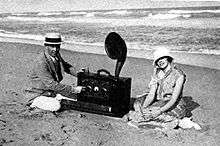Esther Marion Armstrong
| Esther Marion Armstrong | |
|---|---|
 Inventor Edwin Armstrong gave this radio, said to be the 'first portable radio' to his wife Marion in 1923, as a wedding gift. | |
| Born | 1898 |
| Died |
1979 (aged 80–81) New Hampshire |
| Nationality | United States |
| Other names | Esther Marion MacInnis (maiden name) |
| Occupation | secretary, philanthropist |
| Known for | won important patent fights against US electronics firms |
Esther Marion Armstrong was the widow of Edwin Howard Armstrong, notable for continuing his patent battles after despair drove him to suicide.[1] It took 13 years, but she did win all the patent fights, winning financial settlements that restored her wealth.[2] In her final years she established awards and took other steps to honor her husband's accomplishments.
When Marion met Edwin Armstrong she was the secretary of David Sarnoff then an executive at RCA.[2][3] Armstrong was then both an inventor and Professor of Electrical Engineering at Columbia University. He had sold his patents for the autodyne (regenerative circuit) and superheterodyne receiver to Westinghouse, which then owned RCA, making him a millionaire, and owner of a large block of RCA stock. Marion was described as "tall and strikingly handsome".
Armstrong built Marion what was described as "the world's first portable radio".[4] He bought her a Hispano-Suiza sports car as a wedding gift, when they wed in 1923.
By 1933, Edwin Armstrong had filed key patents for techniques he developed that were to eventually make FM Radio successful. His professional relationship with Marion's former boss, Sarnoff, fractured when Sarnoff who was by then the President of RCA, concluded the development of FM Radio was not in the best interests of RCA, which operated an extensive network of commercial AM Radio stations. RCA and over a dozen other electronics firms including Motorola ended up filing competing patents for FM Radio.
These protracted patent fights brought Armstrong to the brink of financial ruin.[1] According to "They made America" Armstrong was oblivious to the toll his struggle was taking on Marion.[5] Marion spent months in a mental hospital after she threw herself into the East River. Finally, on November 1, 1953, Edwin told Marion that he had used up almost all his financial resources. In better times funds for their retirement was put in her name, and he asked her to release a portion of those funds, so he could continue the legal battles. She declined, and suggested he consider accepting a settlement. Enraged, Edwin picked up a fireplace poker, and swung at her. Marion left the apartment, and never saw him again.
After just under three months of separation, on January 31, 1954, Armstrong wrote Marion an apology and threw himself from his high-rise apartment.[1]
Marion inherited her husband's patents, and, by 1967, won all of those patent fights.[6]
According to Jim Wesley's book Radio Memories, after she had begun to win the patent fights, she established awards to honor Armstrong's memory as a radio innovator.[7] Marion established the Armstrong Memorial Research Foundation.[8]
Marion died on August 8, 1979, in New Hampshire, where she had made her home.[9]
References
- 1 2 3 Christopher H. Sterling (2013). Biographical Dictionary of Radio. Routledge Publishing. p. 12. ISBN 9781136993756. Retrieved 2013-08-25.
The years of litigation had taken their toll. His one-time friend David Sarnoff was not his bitter enemy. His fortune was depleted. In a fit of rage in November 1953, he took his anger out on Marion, his wife of 30 years, and she fled their apartment.
- 1 2 Adrian Hope (1979-02-01). The Battles of Armstrong: Radio's Forgotten Man. New Scientist magazine. pp. 306–309. Retrieved 2013-08-25.
- ↑ Evan I. Schwartz (2009). "he Last Lone Inventor". Harper Collins. pp. 74, 76, 77. ISBN 9780061856143. Retrieved 2013-08-25.
During the negotiations, Armstrong had flirted constantly with Sarnoff's beautiful, young, blonde secretary, Marion MacInnis. After one session, he whispered to her a bit of news: I'm going to celebrate my new fortune by vacationing in Europe, but when I get back I'm going to drive by in the world's most expensive car and take you for a ride.
- ↑ "Who made America: Edwin Armstrong". PBS. Archived from the original on 2004-09-25. Retrieved 2013-08-25.
To impress his future wife, Armstrong climbed to the top of two different New York City radio towers on the same day — a tragic foreshadowing of his suicidal jump years later.
- ↑ Harold Evans, Gail Buckland, David Lefer (2009). They Made America: From the Steam Engine to the Search Engine: Two Centuries of Innovators. Hachette Digital. ISBN 9780316070348. Retrieved 2013-08-25.
The stress of living with a man obsessed put Marion into Psychiatric care. She tried to jump into the East River. She spent months in a mental hospital. Armstrong seemed oblivious to everything except the injustice being done to him.
- ↑ Adrian Hope (1979-02-01). "The Battles of Armstrong: Radio's Forgotten Man". New Scientist magazine. pp. 306–309. Retrieved 2013-08-25.
- ↑ Jim Wesley (2011). Radio Memories. Xlibris Corporation. p. 100. ISBN 9781456897192. Retrieved 2013-08-25.
Through all of the years of waiting for the new medium to be accepted, Mr. Armstrong's widow, Marion Armstrong, continued to pursue her husband's patent fights and finally prevailed. She then worked to honor his memory. I met Mrs. Armstrong in the 1960s when she began to attend FM radio industry meetings to present programming awards which she had established in his name.
- ↑ "Celebrating Edwin Armstrong, the man who gave us FM radio". Sciencelens. 2012-12-18. Retrieved 2013-08-25.
His wife, Marion McInnis, used the money from the patents to establish the Armstrong Memorial Research Foundation, with which she was involved until her death in 1979.
- ↑ "Esther Armstrong, 81, the Wife Of Inventor of FM Radio System". New York Times. 1979-08-10. Retrieved 2013-08-25.
Esther Marion Armstrong, the wife of the late Maj. Edwin Howard Armstrong, a leading American inventor, died Wednesday at the Exeter (N.H.) Hospital, after a brief illness.